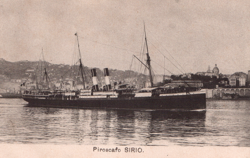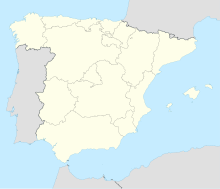Sirio (ship)
|
||||||||||||||||||||
|
||||||||||||||||||||
|
||||||||||||||||||||
|
||||||||||||||||||||
|
||||||||||||||||||||
The Sirio was a passenger ship put into service in 1883 by the Italian shipping company Navigazione Generale Italiana , which was used for the transport of passengers , mail and freight from Italy to South America . On August 4, 1906, the Sirio ran into a rocky reef off the southeast coast of Spain , capsized and sank after a few minutes. 442 passengers and crew members were killed. It is one of the greatest tragedies in the history of Italian steam navigation. It is also called the " Titanic of the Mediterranean ".
The ship
The 4,141 GRT iron- built steamship Sirio was built in 1883 by the Scottish shipyard Robert Napier & Sons in Govan on the Clyde for Societa Italiana di Trasporti Marittimi Raggio & Co., an Italian steamship company based in Genoa . It was 115.8 meters long, 12.8 meters wide and had a draft of 7.6 meters. The steamer could carry 80 passengers in first, 40 in second and 1200 in third class. The Sirio expired on 23 March 1883 from the stack . After the completion of the ship, it sailed from Glasgow to Genoa on June 19, 1883 to be prepared for the maiden voyage . This took place on July 15 of the same year. The Sirio served the route Genoa - Las Palmas - Montevideo - Buenos Aires , for which it took 15 days.
The ship was named after the Italian name for the double star system Sirius . In 1885 the ship was sold to the Navigazione Generale Italiana, one of the largest shipping companies in Italy. The Sirio completed her first voyage in the service of this shipping company on March 21, 1885. In 1891 new engines were installed so that the steamer now managed 15 instead of the previous 14 knots. The Sirio remained on the same shipping route to South America for Navigazione General Italiana.
Downfall

On Wednesday, August 2, 1906, the Sirio left for another crossing from Genoa to Buenos Aires. On board were 570 passengers and 127 crew members. Captain Giuseppe Piccone was in command. The first stop was Barcelona , where another 125 passengers boarded. Thus there were now 822 people on board. Among the first class passengers were some prominent figures such as the then popular Spanish singer and actress Lola Millanes (actually Dolores Erase Millanes ; died), the Bishop of São Paulo José de Camargo Barros (died), the Archbishop of Porto Alegre Cláudio Gonçalves Ponce de Leon (survived), the abbot of Buckfast Abbey Boniface Natter (died), his companion and successor Ansgar Vonier (survived) and the Austrian consul in Rio de Janeiro (survived).
Two days after leaving Genoa, on Friday, August 4, 1906, the ship steamed in clear weather and calm seas along the coast of the Spanish province of Murcia and set course for the port city of Cartagena . Immediately before Cabo de Palos , a cape on the Costa Cálida on the southeast coast of Spain, the Sirio reached the island of Islas Hormigas, in whose bay there are many rocky reefs . The prescribed course for this area provided for extensive circumnavigation of this bay in order to avoid a collision with the rocks . Instead, Captain Piccone took a course that took him deeper into the bay.
At full speed, the Sirio suddenly ran onto the Bajo de Fuera reef at around 5 p.m. The impact on the rocks was so strong that the keel was partially detached from the hull. The stern was pushed underwater while the bow stuck out of the waves. The ship immediately took in water and was seriously listed to starboard . When the water masses reached the engine room , the boilers began to explode .
Panic broke out among the passengers, scenes of chaos and violence took place on deck . There weren't enough lifeboats and few passengers could swim. Instead of helping the passengers, the captain and his officers emptied the safe in the paymaster's office and left the ship in one of the first lifeboats. (For this act, Captain Piccone was later sentenced to prison ). Many fought their way to the boats with knives and revolvers, many of which capsized and sank because they were stormed by the panicked crowds. The passengers trampled each other, many of them jumped overboard. Before the ship could be properly evacuated , it capsized to starboard within a few minutes and sank stern first. 442 passengers and crew were killed, more than half of all people on board. These included numerous women and children. The survivors were rescued from Spanish fishing boats and tugs and brought ashore.
The stranded wreck broke up nine days after the accident and sank, washing away numerous corpses that had been trapped in the ship.
The sinking of the Sirio represents one of the greatest loss of life on a civilian Italian steamship. The disaster was reflected in numerous songs and anecdotes from the region.
Coordinates: 37 ° 39 ′ 6.7 ″ N , 0 ° 39 ′ 10.3 ″ W.
Web links
- Technical and historical data on the Sirio in the Clydebuilt Ships Database
- Brief summary of technical data and sinking
- The wreck of the Sirio as a diving destination
- Entry in the ship directory of The Ships List (almost at the bottom)
- "300 sink with ship; blessed by bishop " (Article in the New York Times August 6, 1906)

